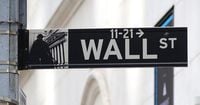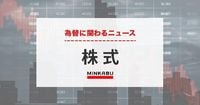On April 16, 2025, the U.S. stock market faced significant turmoil, with the Dow Jones Industrial Average experiencing a dramatic fall of over 900 points, dipping below the 40,000 mark for the first time in recent months. This unsettling decline was largely attributed to rising concerns regarding U.S.-China trade tensions and the impact of U.S. tariff policies on the semiconductor and high-tech industries.
At the close of trading, the Dow settled at 39,488.04, down 880.92 points or 2.18%. The NASDAQ Composite also suffered, ending at 16,111.56, down 711.61 points or 4.23%. Meanwhile, the CME Nikkei Average Futures were reported at 33,785, reflecting a decrease of 135 points or 0.40% compared to the Osaka Securities Exchange close.
European markets had a mixed performance on the same day, with the UK FT100 closing at 8,275.60, up 26.48 points or 0.32%. Germany's DAX rose slightly by 57.32 points to 21,311.02, marking a 0.27% increase, while France's CAC40 saw a minor decline of 5.43 points, ending at 7,329.97.
The turmoil in the stock market coincided with a speech by Federal Reserve Board (FRB) Chairman Jerome Powell, who reiterated the existing stance on monetary policy. His comments contributed to a retreat in early interest rate cut expectations, which weighed heavily on stock prices. The uncertainty surrounding the economic environment, exacerbated by ongoing U.S.-China trade friction, has heightened concerns that these factors will negatively impact the earnings of semiconductor and high-tech companies.
Adding to the anxiety, Nvidia announced on April 15, 2025, that its AI semiconductor 'H20', designed specifically for the Chinese market with reduced performance, would be subject to new U.S. government export regulations. The company indicated that it would face challenges in exporting the H20 as initially planned and projected it would incur costs of up to $55 billion during the February to April 2025 period. Following this announcement, Nvidia's stock plummeted by over 6% as analysts revised their target stock prices downward.
In a related development, Dutch semiconductor manufacturing equipment giant ASML Holding reported a significant drop in new orders for the January-March 2025 period, attributing this downturn to the increasing uncertainty in the economic landscape due to U.S. tariff policies. This uncertainty has cast a shadow over the earnings prospects of semiconductor-related companies, leading to a 3% decline in the Philadelphia Semiconductor Index (SOX).
Despite the struggles in the stock market, some positive indicators emerged from the U.S. retail sector. On April 16, 2025, the U.S. retail sales report for March revealed an increase of 1.4% compared to the previous month, surpassing market expectations of a 1.2% increase as compiled by Dow Jones Communications. Factors such as favorable weather conditions and a rush in consumer demand before anticipated tariff increases contributed to this uptick, particularly in automobile sales.
Notably, even when excluding automobile and auto parts sales, the retail figures still exceeded market expectations. CIBC Capital Markets noted that consumer appetite remained solid during the initial stages of the trade war, reflecting resilience in consumer spending despite broader economic concerns.
On the stock front, major players like Apple, Microsoft, and Amazon saw declines, while Travelers, which announced quarterly results exceeding market expectations, experienced a rise in its stock price. Chevron also performed well, indicating that not all sectors were adversely affected by the market's overall downturn.
As the market closed on April 16, the U.S. bond yields reflected the prevailing uncertainty. The 2-year bond yield was reported at 3.774%, down 0.071%, while the 10-year bond yield stood at 4.267%, down 0.066%. The 30-year bond yield was at 4.739%, down 0.039%. The expected inflation rate decreased slightly to 2.178%, down 0.017%.
Internationally, the bond yields for 10-year securities showed a similar trend, with Germany at 2.509%, the UK at 4.603%, Canada at 3.077%, Australia at 4.344%, and Japan maintaining a yield of 1.263%.
In commodities, the NY crude oil futures for May 2025 rose to $62.71 per barrel, up by $1.38 or 2.25%. Meanwhile, gold futures for June 2025 increased significantly to $3,356.90 per ounce, marking an impressive rise of $116.50 or 3.60%. Bitcoin also saw a slight increase, trading at $84,080.44, up $63.96 or 0.08%. In yen terms, Bitcoin was valued at ¥11,931,855, reflecting a similar increase.
The fluctuations in the stock market and the broader economic indicators underscore a period of uncertainty, as investors remain cautious amidst ongoing geopolitical tensions and shifting economic policies. As the situation evolves, market participants will be closely monitoring developments in U.S.-China relations, Federal Reserve policies, and their potential impacts on various sectors.







